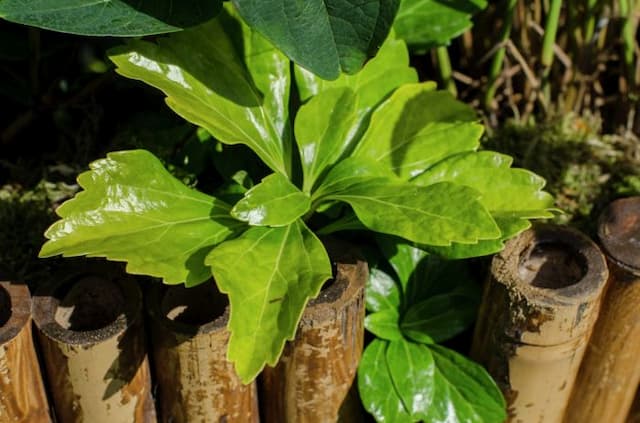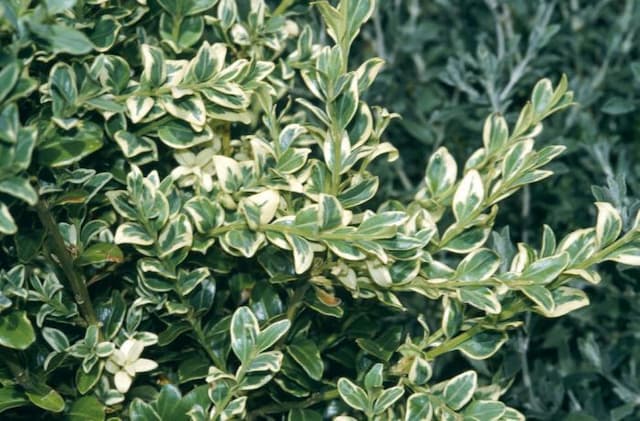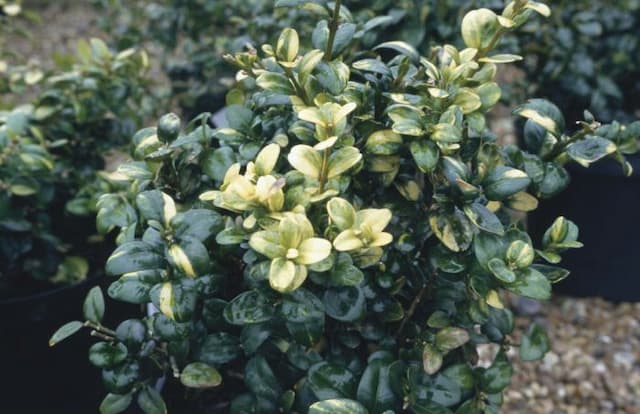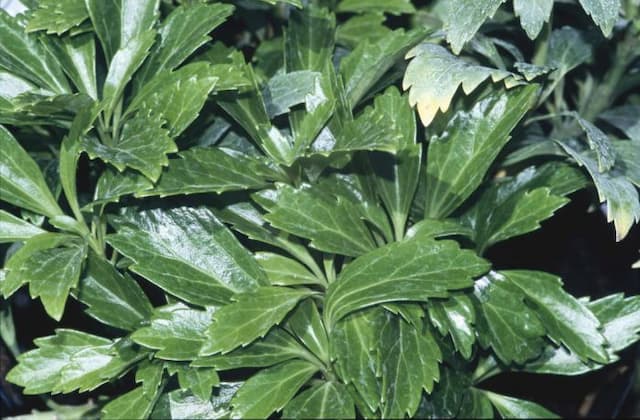Willowleaf Sweetbox Sarcococca saligna

ABOUT
Sarcococca saligna, commonly known as willow-leaved sweet box, is a shrub that is known for its attractive foliage and fragrant flowers. The leaves of this plant are narrow and resemble those of a willow, with a glossy green appearance that can add a touch of elegance to any garden setting. The willow-leaved sweet box blooms with small and inconspicuous flowers that may be overlooked visually, but they more than make up for it with their delightful scent, which can be quite noticeable even from a distance. The flowers of willow-leaved sweet box are characteristically creamy white or sometimes pale yellow, which emerge from the axils of the leaves. Although the individual flowers are not striking in appearance, their sweet fragrance is a highly esteemed feature that makes this plant a popular choice among gardeners who appreciate sensory delights in their outdoor spaces. Following the flowering period, willow-leaved sweet box develops fruits that can provide additional visual interest. The fruits are often in the form of small, round berries that may vary in color, adding a subtle decorative element to the plant's profile. Overall, willow-leaved sweet box is valued for its graceful leaves, aromatic flowers, and the ornamental berries it produces, lending it charm across multiple seasons. Its adaptability and evergreen nature ensure that it provides a constant presence, contributing to the visual and olfactory appeal of gardens throughout the year.
About this plant
 Names
NamesSynonyms
Willow-Leaved Sarcococca, Willow-Leaved Sweet Box
Common names
Sarcococca saligna.
 Toxicity
ToxicityTo humans
Sarcococca saligna, commonly known as willow-leafed sweet box, is not widely recognized for its toxicity to humans. There is limited information available on the specific consequences of ingesting it. However, as a general precaution, it is advisable to avoid consuming any parts of ornamental plants due to potential risks, including gastrointestinal discomfort or more serious symptoms. If ingestion occurs, it is prudent to consult with a medical professional for guidance.
To pets
Willow-leafed sweet box, the most common name for Sarcococca saligna, is not specifically listed as toxic to pets. However, the general rule for non-edible ornamental plants applies: they may have the potential to cause negative reactions if ingested by pets. These could include gastrointestinal upset, vomiting, or diarrhea. If a pet consumes any part of this plant and shows signs of distress, it is important to contact a veterinarian promptly.
 Characteristics
CharacteristicsLife cycle
Perennials
Foliage type
Evergreen
Color of leaves
Green
Flower color
White
Height
3-5 feet (0.91-1.52 meters)
Spread
3-5 feet (0.91-1.52 meters)
Plant type
Shrub
Hardiness zones
7
Native area
Western Asia
Benefits
 General Benefits
General Benefits- Landscape Ornamentation: Sarcococca saligna, commonly known as dwarf sweet box, is often used in gardens and landscapes for its lush foliage and compact growth habit, making it an attractive ornamental plant.
- Shade Tolerance: The dwarf sweet box can thrive in shaded areas where other plants might struggle, making it a good choice for underplanting or filling spaces in woodland gardens.
- Low Maintenance: This plant requires minimal upkeep, with little need for pruning or special care, which makes it an excellent choice for low-maintenance landscapes.
- Fragrant Flowers: Dwarf sweet box produces small, but highly fragrant flowers that can add a pleasant scent to gardens during their blooming period.
- Evergreen Foliage: As an evergreen plant, it provides year-round greenery and structure to gardens, making it valuable for winter interest.
- Drought Resistance: Once established, it is fairly resistant to drought, reducing the need for regular watering and making it suitable for xeriscaping and water-efficient gardens.
- Wildlife Attraction: Sarcococca saligna can attract beneficial insects and birds to the garden, as its flowers provide nectar and its berries offer a food source.
- Erosion Control: The plant's dense root system can help stabilize soil on slopes or in areas prone to erosion.
 Medical Properties
Medical PropertiesThis plant is not used for medical purposes.
 Air-purifying Qualities
Air-purifying QualitiesThis plant is not specifically known for air purifying qualities.
 Other Uses
Other Uses- Sweet Box can be used as a natural insect repellent due to its strong, sweet-smelling fragrance that is pleasant to humans but can deter certain insects.
- It is often planted as ground cover in shady garden spots where other plants might struggle to grow, thanks to its tolerance for low light conditions.
- With its dense growth habit, Sweet Box is used to create low, informal hedges or borders in landscaping designs.
- The plant is suitable for underplanting beneath larger shrubs and trees, providing a lush, evergreen understory in woodland gardens.
- Sweet Box wood, though not commonly harvested, can be utilized for making small, decorative items or inlays in woodworking projects due to its fine grain.
- The berries of Sweet Box can be used to create natural dyes for fabrics, albeit not commonly practiced.
- Gardeners may use the plant to stabilize soil on slopes or banks, as its root system helps to prevent erosion.
- The evergreen leaves of Sweet Box provide year-round greenery, making it a good candidate for winter gardens.
- Sweet Box is sometimes included in sensory gardens for its fragrant flowers that appeal to the sense of smell.
- Floral arrangers may use cuttings of Sweet Box for its foliage and fragrant flowers to add texture and aroma to flower arrangements.
Interesting Facts
 Feng Shui
Feng ShuiThe Sweet Box is not used in Feng Shui practice.
 Zodiac Sign Compitability
Zodiac Sign CompitabilityThe Sweet Box is not used in astrology practice.
 Plant Symbolism
Plant Symbolism- Peace and tranquility: Sarcococca saligna, commonly known as Sweet Box, often symbolizes peace and tranquility due to its calming presence in gardens and its sweet fragrance that can instill a sense of serenity in its surroundings.
- Protection: With its dense and evergreen foliage, Sweet Box is thought to symbolize protection, offering a sheltered space and acting as a natural barrier in garden landscapes.
- Hardiness: This plant's ability to thrive in shaded areas and under tough conditions makes it representative of hardiness and resilience in the face of adversity.
- Eternal life: As an evergreen, the Sweet Box reflects the idea of eternal life, immortality, or persistence, with its persistent green leaves year-round.
 Water
WaterFor Sweet Box (Sarcococca saligna), consistent moisture is key, so it’s important to water the plant when the top inch of soil feels dry to the touch. Depending on the climate and the season, this could mean watering once a week, providing about 1 gallon of water each time for an established plant. During hot, dry periods, you may need to increase watering frequency to ensure the soil doesn't dry out completely, but be careful not to overwater as this plant doesn’t like to sit in soggy soil. During winter, when the plant is not actively growing, you can reduce watering. Always water deeply and directly at the soil level to encourage deep root growth and avoid wetting the foliage.
 Light
LightSweet Box prefers to be in a location that provides partial to full shade, avoiding direct, harsh sunlight, especially in the heat of the afternoon. The best spot for Sweet Box is under the canopy of taller trees or on the north side of a building where it can receive filtered light. The plant can tolerate some morning sun, but too much direct light can scorch its leaves.
 Temperature
TemperatureSweet Box thrives in temperature conditions between 60°F and 80°F but can withstand temperatures as low as 10°F and as high as 95°F. The ideal temperature range, for optimal growth of Sweet Box, is between 60°F and 75°F. It's important to provide protection from extreme cold and minimize exposure to hot temperatures to maintain the plant's health.
 Pruning
PruningPruning Sweet Box is generally done to maintain shape or remove damaged or diseased branches. The best time to prune is in late winter or early spring before new growth starts. Pruning can be done annually if shaping is desired or as needed when you notice parts of the plant that need attention. Always make clean cuts and avoid over-pruning, as it might reduce flowering.
 Cleaning
CleaningAs needed
 Soil
SoilSarcococca saligna, commonly known as Willow-leafed Sarcococca, prefers rich, well-drained soil with a pH between 5.5 and 6.5. A good soil mix for this plant is one part garden soil, one part peat moss or compost, and one part perlite or coarse sand to improve drainage.
 Repotting
RepottingWillow-leafed Sarcococca should be repotted every 2 to 3 years to refresh the soil and accommodate root growth.
 Humidity & Misting
Humidity & MistingWillow-leafed Sarcococca thrives in an environment with moderate to high humidity levels, generally preferring humidity around 50-60%.
 Suitable locations
Suitable locationsIndoor
Place in bright, indirect light and maintain humidity.
Outdoor
Plant in dappled shade with sheltered position.
Hardiness zone
7-9 USDA.
 Life cycle
Life cycleCommonly known as willow-leaved sweet box, Sarcococca saligna begins its life as a seed, often germinating in the spring under favorable moist, shaded conditions. The seedlings establish themselves quickly, developing a root system and growing into small, evergreen shrubs. Over time, the plant matures and develops glossy, lanceolate leaves, and small, inconspicuous creamy-white flowers typically emerge in the winter or early spring. These flowers are highly fragrant and attract pollinators, despite their small size. Following pollination, the plant produces berries, starting green and turning black as they mature, containing the seeds for the next generation. The shrub can also spread vegetatively through root suckers, creating a dense thicket over time.
 Propogation
PropogationPropogation time
Spring-Early Summer
Sarcococca saligna, commonly known as Dwarf Sweet Box, is most commonly propagated through semi-hardwood cuttings. This method involves taking a cutting from a healthy parent plant during the late summer months, usually around July or August. The cutting should include a part of the stem with several leaves, typically about 4 to 6 inches long (about 10 to 15 centimeters). The lower leaves are then removed, and the cut end is dipped in rooting hormone powder to encourage root development. Afterward, the cutting is inserted into a planting medium that is kept moist but not waterlogged. It is important to provide a warm and humid environment for the cuttings by placing them in a greenhouse or under a plastic dome. Rooting can take several weeks, and once the cuttings have developed a healthy root system, they can be transplanted into individual pots to continue growing.









